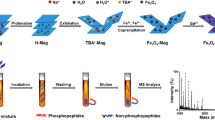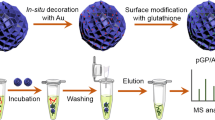Abstract
Graphitic nanofibres (GNFs), 100–200 nm in diameter and 5–20 μm in length have been modified in order to yield different affinities (Cu2+ and Fe3+ loaded immobilized metal affinity chromatography (IMAC) as well as cation and anion exchange materials) for the extraction of a range of biomolecules by their inherited hydrophobicity and the hydrophilic chemical functionalities, obtained by derivatization. Modified GNFs have for the first time been employed as carrier materials for protein profiling in material-enhanced laser desorption/ionization (MELDI) for the enrichment and screening of biofluids. For that purpose, the derivatized GNF materials have comprehensively been characterized regarding surface area, structural changes during derivatization, IMAC, as well as ion exchange and protein-loading capacity and recovery. GNF derivatives revealed high protein-binding capacity (2,000 μg ml−1 for insulin) and ideal sensitivities, resulting in a detection limit of 50 fmol μl−1 (for insulin), which is crucial for the detection of low abundant species in biological samples. Compared to other MELDI carrier materials, sensitivity was enhanced on GNF derivatives, which might be ascribed to the fact that GNFs support desorption and ionization mechanisms and by absorbing laser energy in addition to matrix.





Similar content being viewed by others
References
Abbaspour A, Kamyabi MA (2004) Characterization and determination of stability constants of copper(II)–histidine complexation system by using multivariate curve resolution method of visible spectra and two hard modeling methods in aqueous solutions. Anal Chim Acta 512:257–269
Adam BL, Qu Y, Davis JW (2002) Serum protein fingerprinting coupled with a pattern-matching algorithm distinguishes prostate cancer from benign prostate hyperplasia and healthy men. Cancer Res 62:3609–3614
Aebersold R, Mann M (2003) Mass spectrometry-based proteomics. Nature 422:198–207
Avasarala JR, Wall MR, Wolfe GMJ (2005) A distinctive molecular signature of multiple sclerosis derived from MALDI–TOF/MS and serum proteomic pattern analysis. Mol Neurosci 25:119–125
Cuervo MR, Asedegbega-Nieto E, Díaz E, Vega A, Ordóñez S, Castillejos-López E, Rodríguez-Ramos I (2008) Effect of carbon nanofiber functionalization on the adsorption properties of volatile organic compounds. J Chromatogr A 1188:264–273
Diamandis EP (2004) Analysis of serum proteomic patterns for early cancer diagnosis: drawing attention to potential problems. J Nat Cancer Inst 96:353–356
Ferrari M (2005) Targeted nanoparticle-aptamer bioconjugates for cancer chemotherapy in vivo. Nat Rev Cancer 5:161–171
Feuerstein I, Najam-ul-Haq M, Rainer M, Trojer L, Bakry R, Aprilita NH, Stecher G, Huck CW, Bonn GK, Klocker H, Bartsch G, Guttman A (2006) Material-enhanced laser desorption/ionization (MELDI) a new protein profiling tool utilizing specific carrier materials for time of flight mass spectrometric analysis. J Am Soc Mass Spectrom 17:1203–1208
Feuerstein I, Rainer M, Bernardo K, Stecher G, Huck CW, Kofler K, Pelzer A, Horninger W, Klocker H, Bartsch G, Bonn GK (2005) Derivatized cellulose combined with MALDI–TOF MS: a new tool for serum protein profiling. J Proteome Res 4:2320–2326
Geho DH, Lahar N, Ferrari M, Petricoin EF, Liotta LA (2004) Opportunities for nanotechnology-based innovation in tissue proteomics. Biomed Microdevices 6:231–239
Guo Z, Ganawi AA, Liu Q, He L (2006) Nanomaterials in mass spectrometry ionization and prospects for biological application. Anal Bioanal Chem 384:584–592
Hillenkamp F, Karas M, Beavis RC, Chait BT (1991) Analysis of neutral oligosaccharides by matrix-assisted laser desorption/ionization mass spectrometry. Anal Chem 63:1463–1466
Ho KC, Tsai PJ, Lin YS, Chen YC (2004) Using biofunctionalized nanoparticles to probe pathogenic bacteria. Anal Chem 76:7162–7168
Kirk JS, Bohn PW (2004) Surface adsorption and transfer of organomercaptans to colloidal gold and direct identification by matrix assisted laser desorption/ionization mass spectrometry. J Am Chem Soc 126:5920–5926
Li J, Zhang Z, Rosenweig J (2002) Proteomics and bioinformatics approaches for identification of serum biomarkers to detect breast cancer. Clin Chem 48:1296–1304
Li J, Vergne MJ, Mowles ED, Zhong WH, Hrcules D, Lukehart CM (2005) Surface functionalization and characterization of graphitic carbon nanofibers (GCNFs). Carbon 43:2883–2893
Melechko AV, Merkulov VI, McKnight TE (2005) Vertically aligned carbon nanofibers and related structures: Controlled synthesis and directed assembly. J Appl Phys 97:041301
Merrell K, Southwick K, Graves SW, Esplin MS, Lewis NE, Thulin CD (2004) Analysis of low-abundance, low-molecular-weight serum proteins using mass spectrometry. J Biomol Techn 15:238–248
Najam-ul-Haq M, Rainer M, Huck CW, Stecher G, Feuerstein I, Steinmüller D, Bonn GK (2006a) Chemically modified nano crystalline diamond layer as material enhanced laser desorption ionisation (MELDI) surface in protein profiling. Curr Nanosci 2:1–7
Najam-ul-Haq M, Rainer M, Schwarzenauer T, Huck CW, Bonn GK (2006b) Chemically modified carbon nanotubes as material enhanced laser desorption ionisation (MELDI) material in protein profiling. Anal Chim Acta 561:32–39
Petricoin EF, Ardekani AM, Hitt BA (2002) Use of proteomic patterns in serum to identify ovarian cancer. Lancet 359:572–577
Rainer M, Najam-ul-Haq M, Huck CW, Feuerstein I, Bakry R, Huber LA, Gjerde DT, Zou H, Qian X, Du X, Fang W, Ke Y, Bonn GK (2006) Ultra-fast mass fingerprinting by high-affinity capture of peptides and proteins on derivatized poly(glycidyl methacrylate/divinylbenzene) for the analysis of serum and cell lysates. Rapid Commun Mass Spectrom 20:2954–2960
Rainer M, Najam-ul-Haq M, Bakry R, Huck CW, Bonn GK (2007) Mass spectrometric identification of serum peptides employing derivatized poly(glycidyl methacrylate/divinyl benzene) particles and μ-HPLC. J Proteome Res 6:382–386
Reyzer ML, Caprioli RMJ (2005) MALDI mass spectrometry for direct tissue analysis: a new tool for biomarker discovery. Proteome Res 4:1138–1142
Teng CH, Ho KC, Lin YS, Chen YC (2004) Gold nanoparticles as selective and concentrating probes for samples in MALDI MS analysis. Anal Chem 76:4337–4342
Tijmen GR, Van Dillen AJ, Geus JW, Koningsberger DC (2002) surface oxidation of carbon nanofibres. Chem Eur J 8:1151–1162
Vallant RM, Szabo Z, Trojer L, Najam-ul-Haq M, Rainer M, Huck CW, Bakry R, Bonn GK (2007) A new analytical material-enhanced laser desorption ionization (MELDI) based approach for the determination of low-mass serum constituents using fullerene derivatives for selective enrichment. J Proteome Res 6:44–53
Whitehouse CM, Dreyer RN, Yamashita M, Fenn JB (1985) Electrospray interface for liquid chromatographs and mass spectrometers. Anal Chem 57:675–679
Xiao Z, Adam BL, Cazares LH (2001) Quantitation of serum prostate-specific membrane antigen by a novel protein biochip immunoassay discriminates benign from malignant prostate disease. Cancer Res 61:6029–6033
Zhang Z, Bast RC, Yu Y, Li J et al (2004) Three biomarkers identified from serum proteomic analysis for the detection of early stage ovarian cancer. Cancer Res 64:5882–5890
Zhong G, Amel AA, Ganawi H, Lin QL (2006) Nanomaterials in mass spectrometry ionization and prospects for biological application. Anal Bioanal Chem 384(3)
Acknowledgments
This work was supported by the Genome Research in Austria (GEN-AU) (Federal Ministry for Education, Science and Culture, Vienna, Austria), by the West Austrian Initiative for Nano Networking (WINN) and by the Austrian Science Foundation (FWF), SFB Project 021 (Vienna, Austria).
Author information
Authors and Affiliations
Corresponding author
Rights and permissions
About this article
Cite this article
Greiderer, A., Rainer, M., Najam-ul-Haq, M. et al. Derivatized graphitic nanofibres (GNF) as a new support material for mass spectrometric analysis of peptides and proteins. Amino Acids 37, 341–348 (2009). https://doi.org/10.1007/s00726-008-0159-x
Received:
Accepted:
Published:
Issue Date:
DOI: https://doi.org/10.1007/s00726-008-0159-x




